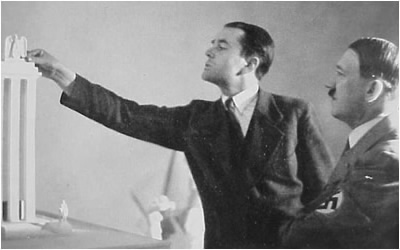| |



 |
|
Albert Speer (march 19,
1905 - september 1, 1981), sometimes called the first architect of the Third
Reich, was Adolf Hitler's chief architect, and later Minister of Armaments
and War Production in Nazi-Germany.
Although
Speer originally wanted to become a mathematician, he ended up following in
the footsteps of his father and grandfather, studying architecture instead.
After completing his studies in 1931, he married Margarete Weber. Later that
year, some fellow students convinced him to attend a national-socialist
party rally, where he found himself mesmerized by Adolf Hitler. Within the
week, he had joined the Nazi party. As he claimed himself, he "became a
member of the party of Hitler", instead of the Nazi party.
His first
architectural commission as a party member came in 1933. Joseph Goebbels,
Minister of Propaganda, appointed him for the renovation of the Propaganda
Ministry. Goebbels was impressed by Speer's work, and recommended him to
Hitler.
Because of
their shared interest in architecture, Speer and Hitler became close
friends. Speer spent more and more time within the inner circle around the
Führer.
In 1934, Paul
Ludwig Troost, Chief Architect of the Third Reich, died, and Speer was
chosen to replace him. One of his first commissions after this promotion was
perhaps the most familiar of his designs: the Nuremberg parade grounds. The
rally grounds were based on ancient Doric architecture of the Pergamum Alter
in Turkey, but magnified to an enormous scale, capable of holding over
240,000 people. At the 1934 party rally on the grounds, Speer surrounded the
Zepplinfield with 150 anti-aircraft searchlights. This created the
effect of the cathedral of light, as it was called by the British
ambassador, Sir Neville Henderson.
Nuremberg was
also to be the site of many more official Nazi buildings, from which some
were never built. The German Stadium, for example, would have held another
400,000 spectators as the site of the Aryan Games; a proposed replacement
for the Olympic Games. While planning these buildings, Speer invented the
theory of ruin value. According to this theory, all new buildings would be
constructed in such a way that they would leave aesthetically pleasing ruins
thousands of years in the future. Speer decided to propose this policy to
Hitler, and to everyone's surprise (after all, Speer's theory would mean
that the buildings of the Third Reich would one day be simple remainings
from the past) he enthusiastically supported Speer's proposal. Such ruins
would be a testament to the greatness of the Reich, just as ancient Greek
and Roman ruins were symbols of the greatness of their civilizations.
The 1937
Paris world exposition organization had placed the Soviet pavilion directly
across the street from the German. Hitler, offended, wanted to abandon from
participation. Speer, who had seen the Soviet pavilion plans by coincidence,
convinced him otherwise.

A year later,
in 1938, Hitler assigned Speer for the total reconstruction of Hitler's
Reich Chancellery in the capital of Berlin. However, Hitler gave Speer only
one year time for this task. The same night, he started drawing sketches,
and he assured Hitler the work would be done within the year. Hitler was
amused as he wanted to see if the young architect really could manage to do
what he had promised him. Speer's architectural and organizational talents,
however, gave him the possibility to complete the work within time. The new
Chancellery included a Marble Gallery twice as long as the Hall of Mirrors
in the Palace of Versailles, and a 400 metres in square office for the
Führer.
Almost none
of the other buildings planned for Berlin were ever built. Berlin was to be
reorganized along a central three-mile long avenue. At the north end, Speer
planned to build an enormous domed building, based on the St. Peter's
Basilica in Rome. The dome of the building would have been impractically
large; it would be over seven hundred feet high and eight hundred feet in
diameter, sixteen times larger than the dome of St. Peter's. At the southern
end of the avenue would be an arch based on the Arc de Triomphe in Paris,
but again, much larger; it would be almost four hundred feet high, and the
Arc the Triumph would have been able to fit inside its opening. The outbreak
of the second World War in 1939 led to the abandonment of these plans.
Hitler
supposedly had a weakness for the young and handsome Speer, whose designs
were considered expressions of national-socialist principles. Hitler made
him Minister of Armaments and War production in 1942, to replace Dr. Fritz
Todt, who had died in a plane crash earlier that year.
Speer worked
diligently to increase war production, even though it became more and more
obvious that Germany was facing imminent defeat. However, he also became one
of the few Nazi leaders to stand up against Hitler and his increasingly
maniacal demands. Speer refused to carry out Hitler's scorched earth policy,
which demanded the annihilation of industry and infrastructure. However,
Hitler continued to consider Speer a friend. When Speer was one of the last
people to visit him in his bunker under the Reich Chancellery in Berlin,
Hitler had tears in his eyes.
After Germany
had surrendered to the Allies, Speer was placed under arrest. He pleaded
guilty at the Nuremberg Trials, and was sentenced to 20 years imprisonment
in Spandau Prison, largely for his use of slave labour during his time as
minister of the cabinet. His release from prison, in 1966, was a world-wide
media event. He published several semi-autobiographical books until his
death in London on September 1st, 1981. His books, such as Inside the
Third Reich, provided an unique and personal view into the personalities
of the Nazi era. Many critics, however, believe that his books understate
his role in the atrocities of the time.
Sources
for this biography include:
wikipedia,
Spartacus Educational,
Albert Speer: the architect of the 20th century,
Joachim Fest's Speer, Gitta Sereny's Albert Speer: His Battle with
Truth. |
|
|
 |
![]()